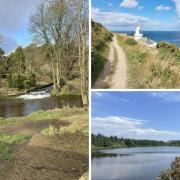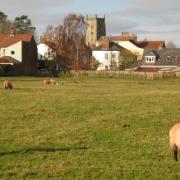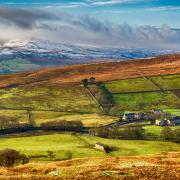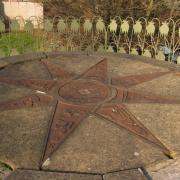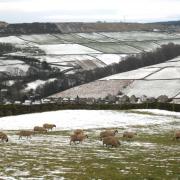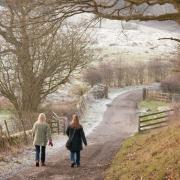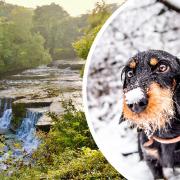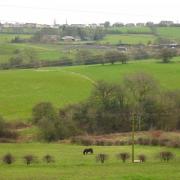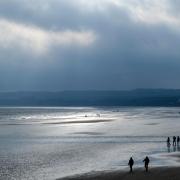Take in the fine cliff scenery on this rewarding coastal walk.

This walk was published in June 2013, so the details of the route may no longer be accurate, we do advise these articles should only be used as a guideline for any potential route you take and you should double check an up to date map before you set off.
Like many of the walks on this stretch of coastline north of Scarborough and Whitby this one combines the use of the Cleveland Way cliff top path and the trackbed of a disused railway, though this section had already lost its services in the 1950s even before Dr Beeching could wield his notorious axe.
It starts from the picturesque former fishing village of Runswick Bay, where the red-roofed cottages tumble down the hillside towards the slipway. At least twice in its history that image has proved terrifyingly apt. In 1682 the entire community save for a single cottage was destroyed in a catastrophic landslip. Fortunately most of the inhabitants were attending a wake and the alarm was raised in time for the entire village to be evacuated with not a single life being lost. Almost 200 years later history repeated itself and a second landslip carried away an iron works.
Today Runswick Bay has an altogether more peaceful air and where fishing boats once tied up picnickers and holidaymakers stretch out along the seawall and the rocky curve of the bay.
DIRECTIONS
The walk begins from the pay and display Bank Bottom car park just above the slipway and the first task is to check the state of the tide. Although the Cleveland Way is an official national trail this is one section where the North Sea asserts its supremacy and a short 100 yard section around the rocky cliffs of Hob Holes is underwater at high tide. If the tide is in either sit and admire the view for an hour or so until it ebbs a few yards or else settle down for an early lunch. Alternatively it is possible to do the walk in reverse which neatly solves the problem and saves the spectacular coastal section for a grand finale.
From the car park walk down to the water’s edge and turn right along the stony beach. Carry on across the pebbles and rocks making for the blue and white buildings of the Runswick Bay Sailing Club at the far end.
The next section crosses the rocky shelves which are awash at high tides as it traverses round the headland of Hob Holes to enter a deep water-worn gully. The path crosses muddy shale ledges guarded by somewhat rickety wooden handrails and then climbs steeply for 300ft (100m) or so to the top of the cliffs, the only climb on the whole route. The reward is a magnificent view back across the water to Runswick Bay huddled below the opposite headland.
The path now sweeps airily along the grass above fine cliff scenery with the imposing headland of Kettleness ahead. Soon the hamlet of Kettleness itself comes into view and the track turns briefly inland to skirt around the first cottage before heading back out past a farm and along the cliff edge.
The path briefly touches tarmac in the centre of the hamlet before heading back onto the headland which is worth visiting to see the scars of the old alum and jet workings. Alum, which was used for tanning leather and dyeing cloth, was mined here from Roman times until the mid 19th century. The black jet that occurs in the cliffs was used for jewellery, especially for mourning pieces after it was popularised by Queen Victoria following the death of Prince Albert. Like its neighbour at Runswick Bay, this cliff was also unstable and at least one set of buildings was lost to landslips.
After visiting the headland retrace your steps to the houses of Kettleness and where the path reaches the road turn along it inland. After the road passes the last building, the old railway station, take a track on the right between two wooden posts. This is the bed of the old railway which is followed almost all the way back to Runswick Bay. After a little less than a mile it almost touches the outward route, which is visible just a field away, but then it sweeps inland in a broad curve, passing through cuttings and bird-filled wooded banks that give the impression of being a living green tunnel enclosing the old railway. Navigation is never a problem and progress can be charted by a series of four bridges spanning the track. After passing a farm at a crossroads of paths the track becomes narrower and more overgrown but is still easy to follow until it comes to an abrupt halt at a road. Here it is time to abandon the old railway and take the lane rightwards back into Runswick Bay and down the steep hill to the car park.
Start/finish: Runswick Bay
Distance: 6.5m/10.5km (including visit to Kettleness)
Time: 3-4 hours
Terrain: Cliff top paths and an old railway
Parking: Pay and display in Runswick Bay. Limited free parking at top of the hill
Refreshments: Café and pubs in Runswick Bay
Map: OS OL 27 North York Moors Eastern area
NOTE: Remember to check tide times




